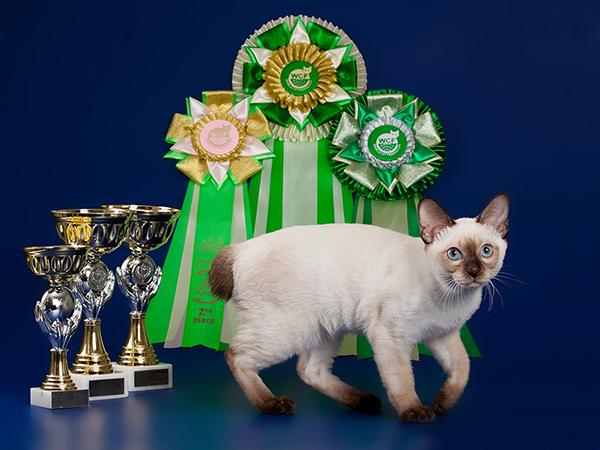- Shortcut:
- MBT
- Group:
- Siamese
- Сategory:
- Primary
- Origin:
- Russia
The origin of the breed

The first specimen of the breed were brought in 70-s from from Southeastern Asia, particularly Burma, Laos, Cambodia, Vietnam and China. These felines and their later ancestors would set up the genetic pool for the new breed complex entitled as the Thai Bobtail. The first WCF-approved standard for the breed was proposed by russian felinologist O. S. Mironova in December 1994. The standard’s contents was accepted by russian and CIS branch of WCF felinological expert group. That standard has banned crosses between Thai Bobtail and Thai cat, citing the differences in their head, body, eye and ear posture and form. In 2003 there was a first showcase of the breed, and in 2004 the WCF General Assembly has admitted the standard, labeling the breed as Mekong Bobtail. The name honors the forefathers of the breed - imported felines from South-Asian countries, transfixed by the Mekong river. One should know about Lyudmila Esina’s contribution to the development, assertion and establishment of the breed, without which it’s existence would never be feasible.
Appearance

Mekong bobtail is a natural short-tailed breed. They come as average-sized, muscular and lean felines, strongly affected by sexual dimorphism with males weighing 7 to 9 lbs and female’s weight varying between 6 and 7 lbs. The breed is characterised by a unique trait of it’s rear claws - they are always held in condition one, without any ability to be tucked in.
Head: Average in length and oval in shape, the head is defined by high jaws on the sides and flat forehead on top. The nose is rather roman, shaped as a smooth curve from the bridge to the tip. The nose is average in length and has even width throughout. The muzzle is oval, transition to the skull is “stopless”. Chin is strong, on the same vertical plane as the nose tip. Male cats have visibly broader jaws due to all the “extra” skin.
Eyes: Large, oval, almost straight set. The colour is blue, brighter hues being the most desired.
Ears: Large, broad at base and slightly tipping forward, with somewhat rounded tips. The outer edge is turned slightly backwards, and the distance between ears should not exceed the width of an ear at base.
Body: Rectangular, medium sized, fit yet elegant and slim.
Legs: Somewhat thin, average in length.
Paws: Oval and neat.
Tail: A configuration of kinks, curves and twists it has to be flawed at base, yet remain articulate.
Coat: Short, shiny, clinging and smooth to the touch, with minimal undercoat. The skin is very elastic and does not stick too well to musculature, adding to that “extra skin” feel on the spine, neck and face.
Colours: Siamese (point) pattern without white, points should be quite sharp. The head mask is diamond shaped and must cover the entirety of the head including muzzle pads, but not the nape. Belly area should be brighter and spotless, adults are allowed to gently darken with age.
Flaws: Limbs too short or too long; round paw pads; weak chin and narrow lower jaw; too close or too deeply set eyes; small ears; missing whisker-break, excessive undercoat, too soft or too hard coat structure.
No CAC title awarded: straight nasal bridge; round forehead; round, short or wedge-shaped skull.
Disqualification on shows: Absent or consisting of less than 3 vertebrae tail; apparent crossing with other breeds; straight and/or immobile tail with no kinks or breaks; tail longer than ¼ of body length; first tail vertebrae without abnormalities; shorter than normal body and/or arching spine; long hair;
Universal disqualification: Amputated claws, cryptorchidism, deafness.
Character traits and features

Mekong bobtail’s temper is both unruffled and tender, devoted to it’s owner and walking on a lash unlike the dogs, with master’s shoulder being the preferred walking manner. The clip-clopping sound produced by their ever armed tread and the tendency to prefer teeth over claws as a tool or weapon is also more common to dogs. It is decently sociable and talkative, having a peculiar habit of watching it’s owner in the eye without blinking for extensive period of time. It’s males do team up with the kids much better than the felines do. These cats are well-suited to be transported by car, unless you violate their speed limit (which is different to every Mekong), in case you do - the feline will siren at you to slow down. The breed is characterised by dominant matriarchy with males doing the job of bringing up, educating and acquainting the litter with everything from rations to toilets, and felines watching over males doing so. Mekong bobtails benefit from a surprisingly long average lifespan of 20-25 years, staying sexually and diligently active until the near death.
Maintenance and care
Mekong bobtail has a short, clinging hair that needs no additional oomph, your cat is more than capable of maintaining it’s coat.
Nutrition choices
A balanced, carnivore ration is recommended. It is advised to eliminate the fist from the diet.
Selection and breeding
Allowed crossings: нет
Breeds relative or derived from Mekong Bobtail: none
Alternative and obsolete breed names
Thai bobtail;
Mekong-bob.
